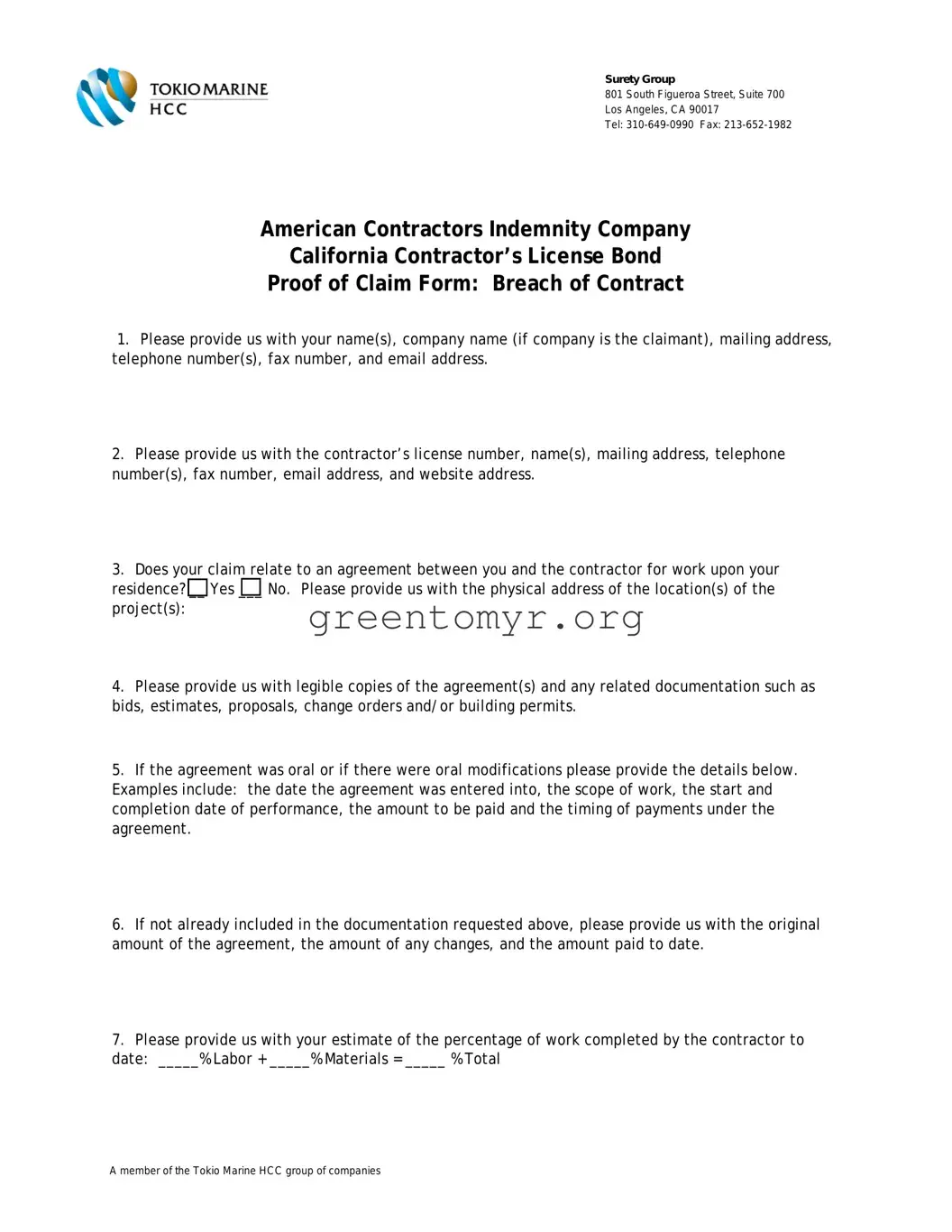
Surety Group
801 South Figueroa Street, Suite 700
Los Angeles, CA 90017
Tel: 310-649-0990 Fax: 213-652-1982
American Contractors Indemnity Company
California Contractor’s License Bond
Proof of Claim Form: Breach of Contract
1.Please provide us with your name(s), company name (if company is the claimant), mailing address, telephone number(s), fax number, and email address.
2.Please provide us with the contractor’s license number, name(s), mailing address, telephone number(s), fax number, email address, and website address.
3.Does your claim relate to an agreement between you and the contractor for work upon your residence? __ Yes ___ No. Please provide us with the physical address of the location(s) of the project(s):
_____________________________________________________________________________________
____________________
4.Please provide us with legible copies of the agreement(s) and any related documentation such as bids, estimates, proposals, change orders and/or building permits.
5.If the agreement was oral or if there were oral modifications please provide the details below. Examples include: the date the agreement was entered into, the scope of work, the start and completion date of performance, the amount to be paid and the timing of payments under the agreement.
6.If not already included in the documentation requested above, please provide us with the original amount of the agreement, the amount of any changes, and the amount paid to date.
7.Please provide us with your estimate of the percentage of work completed by the contractor to date: _____% Labor + _____% Materials = _____ % Total
A member of the Tokio Marine HCC group of companies
8.If you assert you were damaged by the contractor abandoning your construction project without legal excuse, provide us with the following: the date(s) of abandonment; copies of correspondence or other documentation that relate to this assertion; a description of the history and circumstances; and the amount of damages you assert that were caused by the abandonment.
9.If you assert you were damaged by the contractor diverting contract funds paid to it for use on your construction project and/or failing to account for the use and application of payments received, provide us with the following: dates of the payments; copies of the payments; copies of preliminary notices, mechanic’s liens and related correspondence from the contractor’s subcontractors and suppliers; a description of the history and circumstances; and the amount of damages you assert that were caused by the diversion of funds and/or failure to account.
10.If you assert you were damaged by the contractor failing to follow accepted trade standards for good and workmanlike construction, provide the following: a description of what work you believe was performed poorly; written evaluations of the contractor’s work from other licensed contractors; written estimates to repair or replace the contractor’s work; if you believe pictures or diagrams would assist us in understanding the poor work, we invite you submit those pictures along with this claim form, or you can email them to the claim examiner assigned to your claim after we receive your claim package.
11.After we receive your claim package and confer with the contractor, we may retain an independent construction consultant to inspect the contractor’s work under certain circumstances. If you elect to proceed to have the work completed before such an inspection may be performed, if possible, take pictures of the first contractor’s work that you elect to repair or replace. Also, please provide us with the contact information of the subsequent licensed contractor you utilize to perform the work and copies of the related documentation.
12.If you assert you were damaged by the contractor materially breaching the contract, provide us with the following: the date(s) of the material breach; copies of correspondence or other documentation that relate to this assertion; a description of the history and circumstances; and the amount of damages you assert that were caused by the material breach.
A member of the Tokio Marine HCC group of companies
13.If you assert you were damaged by the contractor failing to progress with construction with reasonable diligence, provide us with the following: the date(s) the work stopped progressing with reasonable diligence; copies of correspondence or other documentation that relate to this assertion; and a description of the history and circumstances.
14.If you have filed a complaint with the Contractor’s State License Board (“CSLB”), please provide us with copies of your complaint form and any correspondence between you and the CSLB to date and subsequent to your submission of this claim form.
15.If you are or become involved in litigation, arbitration or other legal proceeding with the contractor regarding this claim, please inform us of same and provide us with copies of the paperwork relating to that legal proceeding. You are not required to obtain a judgment against the principal prior to asserting a claim on the bond, but legal proceedings between the claimant and the contractor are relevant to our investigation of your claim.
FOR YOUR PROTECTION, CALIFORNIA LAW REQUIRES THE FOLLOWING TO APPEAR ON THIS FORM:
(California Insurance Code Section 1871.2)
“...Any person who knowingly presents a false or fraudulent claim for the payment of a loss is guilty of
a crime and may be subject to fines and confinement in State Prison.”
CERTIFICATION
The answers to this Proof of Claim form being the basis for a claim for payment of money under the terms and provisions of the California Business and Professions Code, Division 3, Chapter 9, beginning with Section 7000, et seq., and the undersigned hereby certifies and declares under penalty of perjury that the foregoing is true and correct.
Dated: ________________, _______ (Month - Day) |
(Year) |
Place of Execution: __________________, California |
|
(City) |
|
Signature of Complainant: ________________________________
A member of the Tokio Marine HCC group of companies



